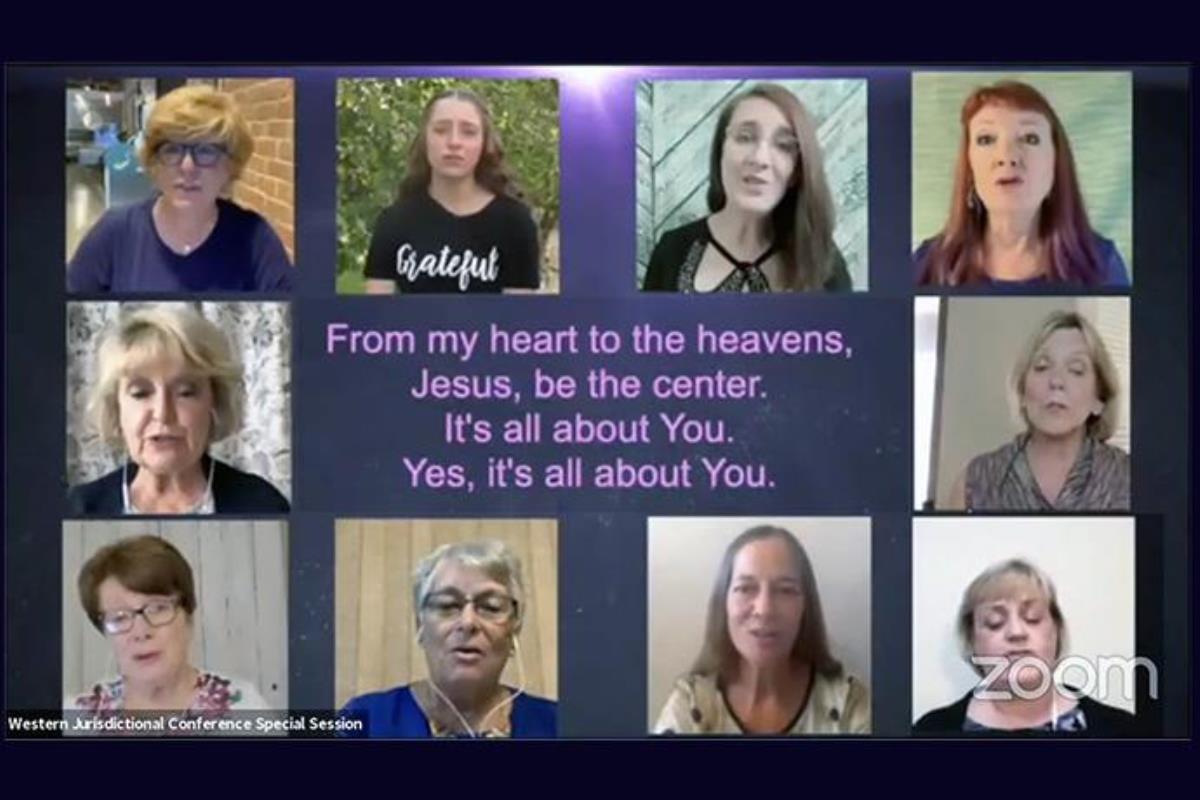교단이 마주하게 될 미래의 파장을 염두에 두고, 미국 내 지역총회 중 두 곳에서 최근 화상으로 임시 지역총회를 개최했다.
• 동남부 지역총회는 멤피스 연회와 테네시 연회가 통합된 테네시-서부 켄터키 연회를 승인했다.
• 서부 지역총회는 감독의 수를 줄이고, 사역을 재구성 할 수 있는지를 논의했다.
최근 두 곳의 연합감리교회 지역총회는 교단의 미래를 생각하며, 화상으로 임시 지역총회를 개최했다.
7월 21일, 동남부 지역총회는 오랫동안 추진해오던 테네시 연회와 멤피스 연회의 통합을 335대 3으로 승인했다. 이에 따라, 새로운 테네시-웨스턴 켄터키 연회는 1월 1일부터 하나의 연회로 활동이 가능하게 되었다.
7월 17일, 서부 지역총회는 감독의 수를 줄이고, 사역을 재구성할 수 있는 가능성에 관해 논의했다. 총회에 참석한 대의원들은 또한 지역총회의 사명 선언문과 연회의 경계를 넘어서는 더 큰 협력 사역의 필요성과 감독의 역할에 관한 보고서를 검토했다.
 연합감리교뉴스의 주간 e-뉴스레터인 <두루알리미>를 받아보시려면, 지금 신청하세요.
연합감리교뉴스의 주간 e-뉴스레터인 <두루알리미>를 받아보시려면, 지금 신청하세요.
두 지역총회 모두 연합감리교회가 직면한 불확실성을 다루었다.
전 세계적 교단인 연합감리교회는 성소수자 이슈로 수십 년에 걸친 치열한 논쟁을 거친 후, 그것을 해결하기 위한 교단 분리뿐만 아니라 코로나19로 인한 지속적인 폐해에도 직면한 상태다.
퍼시픽 노스웨스트 연회의 연대사역협의회 총무로 섬기고 있는 데이비드 발레아 목사는 서부 지역총회에서, “교단으로서 우리가 어떤 모습이 될 것인지 분명해지기까지는 시간이 걸릴 것이다. 교단 분리에 관한 문제는 2022년 총회에서 결정할 수도 있겠지만, 새로운 교단의 성격과 구조가 드러나는 데에는 적어도 8년 내지 10년의 세월이 걸릴 것이라는 의견도 있다.”라고 말했다.
코로나19 대유행으로 인해 교단의 최고 입법기관인 총회는 2022년 8월 29일부터 9월 6일까지 열기로 일정이 재조정되었다. 이는 현재 어떤 공식적인 교단 분리 논의도 중단된 상태임을 뜻한다.
그와 함께, 미국 내 지역총회가 열릴 때 통상적으로 열리던 감독 선거도 연기되었다. 교단의 총감독회는 새로운 감독 선출을 총회 이후로 미뤄야 한다고 선언한 바 있다. 다섯 개의 미국 내 지역총회는 현재 2022년 11월 2일에서 4일로 예정되어 있다.
그러나 여전히 사역은 계속되고 있다. 동남부와 서부 지역총회는 모두 교단의 헌법인 장정이 요구하는 결정을 내리기 위해 임시 지역총회를 열고, 교단의 미래를 향한 몇 가지 안건을 다루었다.
 7월 21일 동남부 지역총회 개회 예배에서 동남부 지역총회의 어린이들이 찬송가 “예수 사랑하심은”을 부르고 있다. 특별 총회의 주제는 “성경에서 배웠네”였다. 사진은 동부 지역총회의 화상 지역총회 화면 갈무리.
7월 21일 동남부 지역총회 개회 예배에서 동남부 지역총회의 어린이들이 찬송가 “예수 사랑하심은”을 부르고 있다. 특별 총회의 주제는 “성경에서 배웠네”였다. 사진은 동부 지역총회의 화상 지역총회 화면 갈무리. 동남부 지역총회는 압도적인 표 차로 테네시-서부 켄터키 연회의 결합을 허락하고 새로운 연회 경계를 확정했다.
테네시 중부에서 미시시피 북서지역인 델타 지역에 이르는 테네시 연회와 멤피스 연회의 통합 준비는 2017년부터 시작되었고, 훨씬 이전부터 비공식적인 대화가 오갔었다. 두 연회는 오랫동안 같은 감독의 치리를 받고 있었고, 여러 사역을 공유해왔었다. 또한 두 연회는 2019년 87% 이상의 표결로 통합을 승인한 바 있다.
새로운 연회의 탄생을 이끈 지도자 가운데 한 명인 멜린다 브리타 목사는 “우리의 새로운 연회가 탄생 중이다. 그 결과 우리가 할 수 있는 사역과 비전 그리고 선교가 확장될 것이며, 한 연회로서는 할 수 없었던 일들도 열매를 맺게 될 것이라고 믿는다.”라고 말했다.
연회 지도자들은 12월에 조직 개편을 위한 연회를 개최하고, 1월에 새로운 테네시-서부 켄터키 연회를 열기 위한 마지막 단계를 밟을 계획이다.
새로운 연회의 구성은 다가올 총회에 참석할 총회의 대의원과 정기적인 지역총회의 대의원 수에는 영향을 미치지는 않는다. 멤피스와 테네시 연회 모두 기존의 연회에서 선출했던 대의원들을 지역총회에 보낼 것이다.
동남부 지역총회는 또한 2022년 다음 정기 지역총회에서 결정해야 할 사안을 사전 심사했다. 레드버드 선교연회는 선교 지역을 더 잘 반영할 수 있는 이름인 중앙애팔래치아 연회로 개명할 것을 청원하였다.
그러나 연회의 대부분은 코로나19 대유행에 대응하기 위한 사역과 지역총회 내에서의 인종차별을 없애려는 노력과 같은 현재 진행 중인 사역에 초점을 맞추었다.
남캐롤라이나 연회의 감독인 조나단 홀스톤 감독은 그곳에 모인 사람들에게 “현재 우리가 사는 세상에 절실히 필요한 반인종차별 사역을 자신의 일처럼 여겨달라.”라고 지역총회 감독들이 각 연회에 속한 연합감리교인들에게 요청한다고 말했다.
“2020년 2월과 2021년 4월 사이에, 우리 동남부 지역총회는 전국적인 뉴스가 되었던 세 건에 걸친 세 명의 유색인종의 비극적인 죽음을 목격했다.”라고 홀스톤 감독은 말했다. 그리고는 조지아주의 아흐모드 알베리, 켄터키주의 브레오나 테일러 그리고 노스캐롤라이나의 앤드루 브라운 등 각 희생자의 이름을 한 명씩 호명했다.
연회가 끝날 무렵 지역총회는 9월 1일 자로 은퇴하는 로슨 브라이언 감독, 호프 몰간 워드 감독, 폴 리랜드 감독 그리고 메리 버지니아 “딘디” 테일러 감독을 찬하했다.
서부 지역총회의 임시 지역총회 역시 2012년 이후 데저트사우스웨스트 연회를 이끌어온 밥 호시바타 감독의 은퇴를 승인했다. 호시바타 감독이 자원은퇴를 요청했기 때문에, 장정의 규정에 따라 지역총회는 10월 1일 자로 그가 은퇴할 수 있도록 승인했다.
그러나 대부분의 연회는 서부 산악 지대에서부터 하와이와 괌에 이르는 넓은 지역을 포괄하는 서부 지역총회의 미래에 관해 성찰하는 데 사용되었다.
지역총회에 관해 더 알고 싶으시면,
연합감리교회는 미국 내에 다섯 개의 지역총회를 가지고 있으며, 아프리카와 유럽 그리고 필리핀에 일곱 개의 해외지역총회를 가지고 있다. 교단의 중간 의결 기구인 지역총회들과 해외지역총회들은 감독 선출과 연회의 경계를 정해주는 일들을 책임 사역 중 하나로 감당하고 있다.
동남부와 서부 지역총회는 북아메리카 대륙의 반대편에 위치해 있다.
감리교회의 초기 복음 전도 지역이자 가장 오래된 교회들이 있는 동남부 지역총회에는 교단 내 가장 많은 교인이 있다. 이 지역총회는 대서양에서 미시시피강에 이르는 남부 9개 주의 연합감리교회를 포함하고 있다.
동남부 지역총회의 임시 지역총회를 시청하기 원하시면, 이곳을 누르세요.
서부 지역총회는 가장 교인 수가 적은 데 서부 산악 지대부터 알래스카와 하와이 그리고 괌 지역에 이른다. 이 지역총회에는 현재 7개의 연회가 있다.
서부 지역총회의 임시 지역총회를 시청하기 원하시면, 이곳을 누르세요.
GNTV 미디어미니스트리는 두 지역총회를 위한 기술 지원을 맡았다.
서부 지역총회는 오랫동안 모든 사람의 완전한 참여를 옹호해왔으며, 동성 결혼과 “자기 스스로 동성애를 실천한다고 밝힌” 동성 목회자의 안수를 금지한 장정의 내용을 반대하는데 앞장서 왔다.
다가오는 총회에 제출될 중요 안건 중 하나는 많은 이들이 지지한 결별을 통한 화해와 은혜의 의정서이다. 이 안은 전통주의 교회들과 연회들이 자신의 재산을 가지고 교단을 떠나 독립적인 교단을 만드는데 2천 5백만 불의 연합감리교회 재정을 사용하는 것을 허락하는 내용이 포함되어 있다.
서부 지역총회의 많은 사람은 또한 이 새로운 의정서가 장정에 있는 성소수자들과 관련한 제한을 철폐할 수 있도록 길을 열어주길 기대하고 있다. 그러나 5명의 감독 중 4명이 은퇴하는 상황과 교단의 재정적인 어려움으로 인해 교회를 섬길 감독의 수를 줄여야 하는 필요성이 대두되면서, 지역총회는 또 다른 도전에 직면하게 되었다. 제안된 내용 중에는 감독들이 연회의 경계를 넘어 책임을 감당하고, 각 감독이 담당하는 행정 업무를 줄이자는 안도 포함되어 있다.
마운틴스카이 연회의 연대사역협의회 총무로 사역하며, 감독의 역할을 연구하는 모임의 애니 아놀디 목사는 “현대인들의 필요를 채울 새로운 감독에 대한 희망이 있다.”라고 말했다.
“이러한 변화가 불가능하게 느껴질지 모르지만, 우리는 꿈꾸는 사람들이며, 어렵고 변화무쌍한 시기에도 하나님이 우리와 함께 일하신다고 믿는 사람들이다.”
서부 지역총회의 감독들은 오는 11월 13일 두 번째 임시 지역총회를 열고, 2022년에 몇 명의 감독을 뽑을 것인가에 대한 문제를 논의할 계획이다.
일단 동남부와 서부 지역총회에 있는 연합감리교회들은 그들 앞에 놓인 일들을 하나님이 인도해주시기를 기도하고 있다.
지역총회 설교에서 듀크 신학대학교 학장인 에드가도 콜론-에머릭 목사는 이렇게 말했다. “나는 동남부 지역총회 내 연합감리교회의 미래가 어떻게 될지 모른다. 불확실성과 불안 그리고 두려움이 있다.”
“그러나 나는 이것을 안다. 우리의 이야기는 아직도 채워져야 할 빈 책장과 같다. 그리고 예수님은 여전히 우리에게 그 이야기를 자기와 함께 써 내려가자고 우리를 부르고 계신다.”
한은 연합감리교뉴스의 부편집장이다. 연합감리교뉴스에 연락 또는 문의를 원하면 tkim@umnews.org로 이메일 또는 전화 615-742-5109로 김응선 목사에게 연락하시기 바랍니다. 연합감리교뉴스를 더 읽기 원하시면, 주간 전자신문 두루알리미를 신청하세요.




